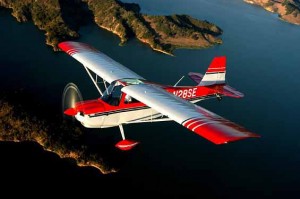One of the finest airplanes produced is the Citabria, which, spelled backward, is “Airbatic.” That was one of the things this little two-place airplane specialized in—aerobatics—going upside down, turning loops, and flying Cuban Eights.
Champion Aircraft originally designed the plane as an offshoot of the Aeronca Champ after the company bought the rights to the Champ series airplanes in 1954. Champion first offered the 7ECA Citabria to the public in 1964.
Originally powered by the Continental O-200 engine of 100 horsepower, the 115 horsepower Lycoming O-235 engine replaced the Continental engine within a year after introduction of the airplane. This airplane was a tough little bird, although a little underpowered for serious aerobatics with either engine.
A year later, Champion introduced the 7GCAA and the 7GCBC. Champion offered both airplanes with the Lycoming O-320 engine of 150 horsepower. Additionally, buyers of the 7GCBC had the option of ordering the airplane with the larger 180 horsepower O-360.
The 7ECA was a perfect airplane for learning to fly, or acquiring tailwheel training. The other two models were more appropriate for “working,” the kind of work that ranchers would do with airplanes.
In 1968, Champion introduced what I considered the best of the Citabria series—the 7KCAB. This airplane had a fuel-injected engine with inverted fuel and oil systems. This allowed for inverted flight for short periods.
The 7-series airplanes were very straightforward in flying characteristics as well as general configurations. The airplanes typical weighed in at around 1150 pounds empty with a useful load of about 500 pounds. Gross weight was 1650 pounds and with a wing area of 165 square feet, the airplane had a respectable wing loading of 10 pounds per square foot. The 150 horsepower engine allows for a power loading of 11.0 pounds per horsepower.
The numbers above gave the airplane respectable performance as a basic acrobatic trainer. She topped out over 120 knots, cruised at 110 on a fuel flow of 8.0 gph, and initially climbed better than 1000 fpm. Typical stall speed was 44 knots and she handled well on concrete as well as grass runways.
As with all airplanes, there was always room for improvement. Refinements on the 7KCAB airframe led to the development of the 8KCAB Decathlon, which became a step up for acrobatic training and more suitable for aerobatic competitions.
If you have a chance to go play with one of these great planes, don’t pass it up.
-30-
© 2010 J. Clark

